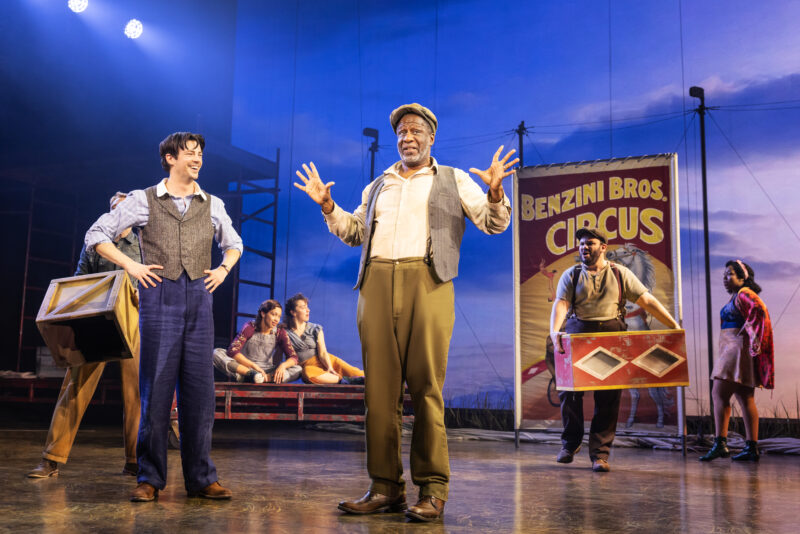
Based on Sara Gruen’s 2006 critically acclaimed bestselling novel, Water for Elephants premiered at Atlanta’s Alliance Theatre last year before landing on Broadway’s Imperial Theatre on March 21st to glowing reviews. The New York Times calls it “a gorgeously imaginative Broadway musical” and Variety hails it as a “seamless integration of theatrical and cirque artistry”.
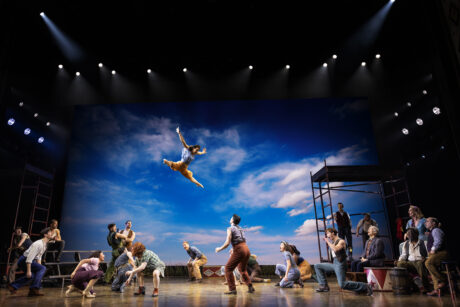 This breathtaking production entertains with daring acrobats, knife throwers, and visually stunning puppetry. The producers and design team, including David Bengali (projection), Bradley King (lighting) Takeshi Kata (scenic), Walter Trarbach (sound), turned to technology partner PRG to provide comprehensive services, including audio, video, lighting, scenery and automation for this stunning spectacle. Alex Donnelly, PRG VP and General Manager for Broadway said, “We have a long relationship with the producers who reached out to us before the show even went to the Alliance Theatre. So, from the beginning, we were working closely with the creative, design, and production teams on the technology and solutions that would allow them to achieve their creative goals. For example, we hosted materials and products tests in our NJ shop and supported a multi-week rehearsal on a soundstage to hone the audio system. Being involved in a show early like that is invaluable not just for PRG, but for the show as well.”
This breathtaking production entertains with daring acrobats, knife throwers, and visually stunning puppetry. The producers and design team, including David Bengali (projection), Bradley King (lighting) Takeshi Kata (scenic), Walter Trarbach (sound), turned to technology partner PRG to provide comprehensive services, including audio, video, lighting, scenery and automation for this stunning spectacle. Alex Donnelly, PRG VP and General Manager for Broadway said, “We have a long relationship with the producers who reached out to us before the show even went to the Alliance Theatre. So, from the beginning, we were working closely with the creative, design, and production teams on the technology and solutions that would allow them to achieve their creative goals. For example, we hosted materials and products tests in our NJ shop and supported a multi-week rehearsal on a soundstage to hone the audio system. Being involved in a show early like that is invaluable not just for PRG, but for the show as well.”
 Adding to the visual experience are David Bengali’s extraordinary projections. “Projection played a crucial part in the visual aesthetics of Water for Elephants. The show uses projection significantly; however, we wanted it to feel like something other than a tech-driven show. Our goal was to create an experience that felt analog, one that celebrates the human and the hand-made,” explained Bengali.
Adding to the visual experience are David Bengali’s extraordinary projections. “Projection played a crucial part in the visual aesthetics of Water for Elephants. The show uses projection significantly; however, we wanted it to feel like something other than a tech-driven show. Our goal was to create an experience that felt analog, one that celebrates the human and the hand-made,” explained Bengali.
Bengali was inspired by matte-paintings like those seen in great epic films of the 1930s and 40s, as well as paintings by Hudson River School artists. Bengali described the evolution of his design from the Alliance Theater to Broadway. “At the Alliance, we sometimes approached the upstage LED wall as more of a traditional cyc. For Broadway, we changed the look of the projections to include more detailed, painterly skyscapes in keeping with the rest of the show. Even for cues and artwork that seem pretty similar to the Alliance version, we did a ton of new work in subtle ways – a slight shift of hue here, an added highlight on a cloud there: It’s those little details that can make all the difference and emotionally impact the audience,” Bengali explained.
On Broadway, the production uses a 53’ wide x 27’ high LED wall. “We chose the ROE CB5 LED because it outshines other options in its ability to produce subtle and painterly effects. It responds beautifully to fine gradations of color in both bright and dark imagery,” Bengali said.
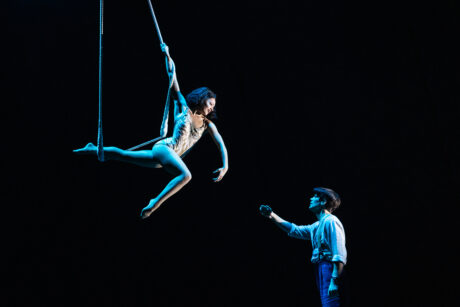 As a projection designer who loves to work with puppetry, Bengali created evocative scenes that echoed the puppets in dreamlike projections while creating the sense of additional animals on stage. Collaborating closely with Lighting Designer Bradley King, he blended projections of filmed and animated content using a pair of converged Barco UDX-4K40 projectors with shadows created by stage lighting. For his design, beyond Bengali’s Hudson River School painter references, King drew from what he describes as the show’s emotional core: the music. Extensive rehearsal time was critical in lighting acrobats safely, ensuring precise timing and avoiding glare in performers’ eyes. King’s design included Mac Ultra fixtures from Martin for its rich color options and high output, along GLP’s X5 for accurate skin tones. The new GLP X5Cs (the mini version of the X5) were strategically placed in the theater’s large scenic pit rail to enhance important footlight and shadow effects.
As a projection designer who loves to work with puppetry, Bengali created evocative scenes that echoed the puppets in dreamlike projections while creating the sense of additional animals on stage. Collaborating closely with Lighting Designer Bradley King, he blended projections of filmed and animated content using a pair of converged Barco UDX-4K40 projectors with shadows created by stage lighting. For his design, beyond Bengali’s Hudson River School painter references, King drew from what he describes as the show’s emotional core: the music. Extensive rehearsal time was critical in lighting acrobats safely, ensuring precise timing and avoiding glare in performers’ eyes. King’s design included Mac Ultra fixtures from Martin for its rich color options and high output, along GLP’s X5 for accurate skin tones. The new GLP X5Cs (the mini version of the X5) were strategically placed in the theater’s large scenic pit rail to enhance important footlight and shadow effects.
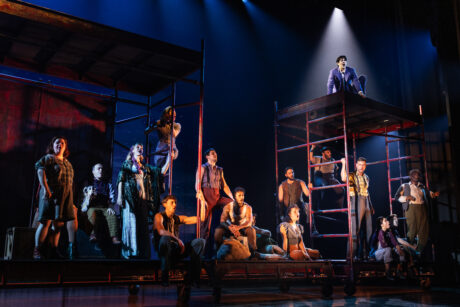 Last but not least, Scenic Designer Takeshi Kata created a wonderous, magical set that coalesced the stagecraft of a large-scale Broadway musical with a live circus performance. Four scaffolding units – the tallest is nearly 13′ and the widest is 8′ – facilitate much of the action. In keeping with the organic feel of the show, the actors continually reposition the stage’s scaffolding to become new performance spaces used by up to twelve actors, acrobats and circus performers. For example, at one point, a wire is locked into the top rails of one scaffold to create a tightrope. Other standout scenic elements include the electrified proscenium portal and the sophisticated haze system that was built into the stage deck to tightly control the smoke effects.
Last but not least, Scenic Designer Takeshi Kata created a wonderous, magical set that coalesced the stagecraft of a large-scale Broadway musical with a live circus performance. Four scaffolding units – the tallest is nearly 13′ and the widest is 8′ – facilitate much of the action. In keeping with the organic feel of the show, the actors continually reposition the stage’s scaffolding to become new performance spaces used by up to twelve actors, acrobats and circus performers. For example, at one point, a wire is locked into the top rails of one scaffold to create a tightrope. Other standout scenic elements include the electrified proscenium portal and the sophisticated haze system that was built into the stage deck to tightly control the smoke effects.
When asked about working with PRG on this elaborate and technically challenging production, Bengali said, “I’ve worked with PRG on several design projects over the years. Even before we started our out-of-town run in Atlanta, Rob Harris, Alex Donnelly and the rest of the PRG team were there to support us, bringing in different products for us to compare and giving us time in the shop to test and evaluate. They really understand the unique needs of theatrical designers,” said Bengali.
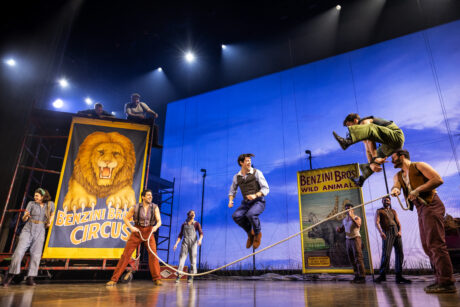 Now people can witness the magic for themselves… Water for Elephants is currently playing at the Imperial Theatre.
Now people can witness the magic for themselves… Water for Elephants is currently playing at the Imperial Theatre.
Learn more about PRG’s work on Broadway here.
Photos by: Matthew Murphy


